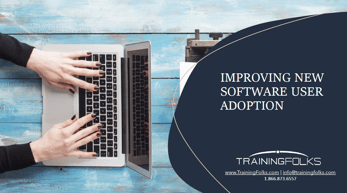Tips That Will Improve New Technology User Adoption

The past decade has seen an immense evolution in technology. Gone are the days of the once-a-year software update, replaced with monthly or even weekly software updates to download, newer and faster hardware to purchase, and the latest and greatest cell phone to buy. With this constant change, how can we all keep up?
Here are five tips that will improve your New Technology User Adoption.
How vital is technology user adoption?
New Technology user adoption is critical to the success of any new technology deployment. As the adage goes, "If you can't measure it, you can't manage it." Without good metrics, organizations will struggle to understand whether their new investments are paying off. Gartner has found that 67 percent of all IT projects fail due to poor user adoption rates. So how do we ensure good user adoption?
Below are the 5 tips:
1) Make new technology easy to use, and explain its benefits
If employees don't understand how the tools work, they will likely do all they can to avoid using them. Try making changes that will make it as easy as possible for your users to get up and running with a tool you introduced. This should include comprehensive, hands-on training. Also, equally important is to ensure you explain the reason behind the change, and how it will benefit your employee – the ‘what’s in it for me’.
This might include changing the default settings on an application (i.e., setting everything at its most superficial level), adding helpful pop-up reminders of everyday tasks, or creating thorough documentation of what each setting means within an app/tool. By taking these steps in advance, you can help reduce the hesitancy some of your team may feel about adopting your new technology.
2) Offer training sessions
Training your team is crucial to getting them on board with using your new technology user adoption. When planning your training, whether in person or virtual - be sure that it's hands-on and interactive.
It is also helpful if the trainer can work with everyone in the session to answer questions as soon as something goes wrong (instead of dragging out the class over multiple days). Once people understand what they need to do, they will likely be more engaged and quickly learn how to accomplish those tasks independently.
It's worth noting that just because someone attends a training session doesn't mean they automatically become an expert user of the technology. But, if you have regular sessions and employees see that there is always something new to learn about the tools they use each day at work, they will be more likely to come back and try again.
3) Look at the big picture
It's easy to get lost in all of the small details that go into making new technology work for your employees.
Try taking a step back and asking yourself: how would I explain this tool/application if I explained its function first? Once you understand where people seem to struggle (and why), try tweaking some settings, so those problems aren't as apparent anymore.
Taking some time before jumping into change is essential, but revisiting those changes later makes sure everything is still running smoothly. Having an efficient change management plan in place is critical for any technology rollout.
It's much easier for users to get onboard with technology user adoption if they feel like it has been made easier for them.
4) Let employees customize
One way to make sure people feel more in control of their work is by giving them the ability to personalize their experience. This can be done in various ways, but one typical example is setting up shortcuts and preferences within an app or tool. For instance, if someone always works on reports on Fridays, they might want quick access to those specific files instead of digging for them each time. Or maybe they prefer to have all of their notifications turned off so that they can focus better during the day?
Allowing employees these small choices helps them take ownership of their work and feel less of a burden. It also gives you some insight into how different people like to work (which can be helpful when you're looking for ways to improve the technology users experience).
When implementing new technology, it's important to consider the different ways that people might use it.
5) Don't forget to include training!
Finally, it's important not to overlook the importance of onboarding and training for any new technology, such as SAP training, Workday training or Salesforce training. Even if everything has been simplified so that employees can use a tool right away, there will probably be some questions or roadblocks along the way. Asking these questions early on helps save time down the line.
Ready to get started with Technology User Adoption training but not sure where to begin?
Download our FREE 'Improving New Software User Adoption' eBook


